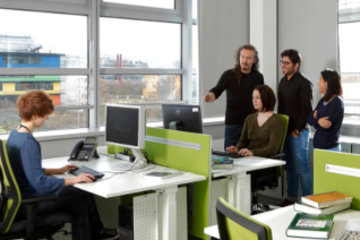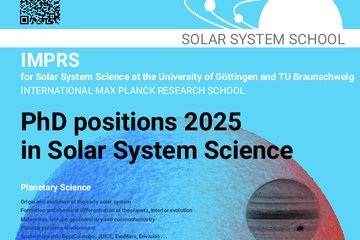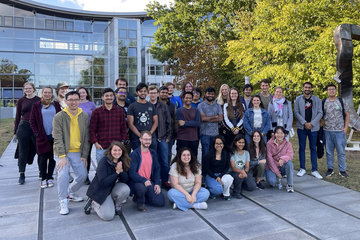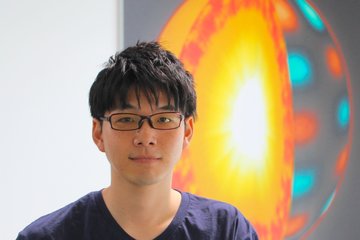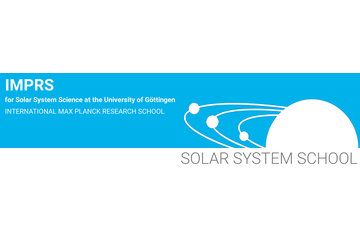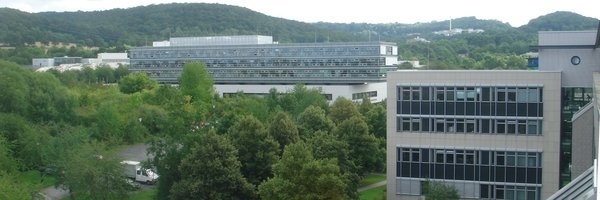
Partner institutions
Detailed presentation of the research expertise and faculty of the academic and research institutions participating in the Solar System School
The school is hosted by the Max-Planck Institute for Solar System Research in Göttingen and jointly run with its partner institutes at the University of Göttingen (Institute for Astrophysics and Geophysics, Geosciences Center). These institutes are uniquely positioned in the fields of Solar system physics with excellent facilities, internationally renowned researchers and experienced teachers.
Introduction
The Solar System School is a joint effort of the Max Planck Institute for Solar System Research, the Institute for Astrophysics & Geophysics and the Geoscience Center of the University of Göttingen. The presence of considerable theoretical expertise, outstanding data from space- and ground-based programs, as well as the involvement of the institutes in the development of space missions and ground-based observatories make the MPS and the partner university institutes the natural location for a school on Solar system science.
The school is implemented as a PhD programme under the roof of the Georg-August University School of Science (GAUSS).
Max Planck Institute for Solar System Research Göttingen
Subjects of investigation are the Sun, its atmosphere and the interplanetary medium, the surfaces, atmospheres, ionospheres and magnetospheres of the planets, their rings and moons, comets and asteroids. The solar corona is observed with optical instruments in space over the spectral range from the visible to soft X-rays. Its plasma properties are determined by spectroscopic methods and by in-situ observations in interplanetary space. The lower solar atmosphere is investigated with spectropolarimetric techniques, both from ground and space. The main aim is to study the Sun's magnetic field and its fundamental role in driving a large number of solar phenomena, many of which constitute the cause of space weather affecting the near-Earth space environment or are suspected drivers of global climate variations.
The planets and their moons, asteroids and comets are investigated with space-borne and ground-based imaging techniques and with in-situ measurements. Research topics comprise the interior structure and dynamics of planets and small bodies, the composition and evolution of their surfaces and atmospheres and the planetary plasma environment. The basic goal is to understand the origin and evolution of the solar system.
The MPS department and university group "Solar and Stellar Interiors" is working towards an understanding of the structure, dynamics, activity, and evolution of the Sun and stars. Techniques of local helioseismology are used to image 3D flow velocities and subsurface heterogeneities in the solar convection zone in order to study subsurface convection and the structure and emergence of active regions and sunspots. The German Data Center for SDO, a unique facility in Europe, stores and processes the observations of helioseismic waves from the Solar Dynamics Observatory. In parallel, efforts are made to apply seismological investigations to distant stars using data from the CoRoT and Kepler satellites.
The institute plays or has played a leading role in a large number of space missions, with Helios, Giotto, Ulysses, SOHO, Solar Orbiter, Sunrise, Cluster, Rosetta, JUICE and PLATO being prominent examples, and operates or has a stake in various ground-based observatories. In the course of this involvement the institute has built up a unique know-how in the design, construction, qualification, and operation of a wide variety of specialized instruments. These instruments are or will be providing high-quality data, which can serve as the basis for many PhD theses. There is also a strong background in theoretical plasma physics at the institute, which is now being augmented by a strong emphasis on numerical simulations applied to geophysics, planetary science and solar and stellar physics. A state of the art multiprocessor computer system allows demanding numerical calculations to be performed.
Besides the directors (Prof. T. Kleine, Prof. L. Gizon and Prof. S. K. Solanki) several habilitated or appointed (through a procedure similar to that for university professors) scientists with long-standing experience in lecturing and mentoring students participate in the Solar System School (Dr. A. Birch, PD DR. Rene Heller, PD Dr. Sandra Jeffers, Dr. N. Krivova, Dr. H. Krüger, Prof. H. Peter, Dr. X. Zhu). Furthermore, younger staff members participate with great enthusiasm. The institute thus provides opportunities for students with a wide range of scientific interests and an excellent basis for studies combining experimental and theoretical methods.
Institute for Astrophysics and Geophysics, University of Göttingen
https://www.astro.physik.uni-goettingen.de
The Institute for Astrophysics in Göttingen is the only university institute in the state of Lower Saxony where teaching and research in astronomy and astrophysics is performed. It is an institute with state-of-the-art facilities within the department of physics at the Georg-August University. Since June 2005 the institute is located in the new building of the physics department, now in close vicinity to the relocated MPS.
The scientific research areas cover the full range of astrophysics using observational data from various ground- and space-based telescopes in combination with numerical simulations as well as theoretical physics. The institute has a long tradition of contributing to the design and building of instruments for ESO, ESA and NASA facilities.
Stellar astrophysics, extra-solar planets and solar physics
Stellar astrophysics is covered by a large variety of methods using asteroseismology, stellar spectroscopy as well as stellar evolution (Profs. Dreizler, Gizon, Reiners). Of specific interest are low-mass M stars, solar-type stars as well as stars in globular clusters. On the one hand stellar astrophysics is closely related to extra-solar planets. Of special interest is the impact of stellar variability on the planet detection. Likewise, a detailed characterization of exoplanets critically relies on the characterization of the planet host star. On the other hand, stellar astrophysics is coupled to galactic astrophysics (Prof. Kollatschny). Globular clusters are primordial building blocks, their dynamics and evolution are used to shed light on galactic evolution. The Sun is used as prototype star for a better understanding of stellar variability, again with a special interest in connection with planets, their detection and characterization as well as their evolution.
Extragalactic astrophysics and cosmology
A large variety of observations over a large range of scales indicate that Dark Matter is dominating structure formation in the universe. The cosmology group (Prof. Niemeyer) currently concentrates on Axions as one of the possible explanations for Dark Matter. Numerical and theoretical cosmological simulations covering various aspects of structure formation from the early universe onward are confronted with astrophysical observations of e. g.the cosmic microwave background and are used to constrain this new physics.
Geophysics
Research and teaching at the Institute for Geophysics concentrates on the structure and dynamics of the interior of the Earth and other planets. Questions of the internal dynamics of solid and fluid planets are addressed by means of computer simulations augmented by laboratory experiments. This topic comprises convective flow in the silicate mantles and in the outer fluid shells of gas planets, the thermal evolution of terrestrial planets, tidal flow, precession driven flow, MHD flow, and magnetic field generation by self-sustained dynamo action in the conducting liquid cores of planets. Participation in the Solar System School is through the group of Prof. Dr. A. Tilgner, whose expertise is in geophysical fluid dynamics with large-scale numerical simulations and laboratory experiments.
Geoscience Center, University of Göttingen
Department of Geobiology - Geoscience Centre, University of Göttingen / Geobiology Research Group
Geochemistry and Isotope Geology Department - Geoscience Center, University of Göttingen
Geobiologie, Geochemistry & Isotope Geology
Research conducted at the Geoscience Center (GZG) covers a wide field of topics, including structural geology, sedimentology, mineralogy, petrology and isotope geochemistry of terrestrial rocks and meteorites and the biochemistry of microorganisms and their specific environments. Most relevant to the participation in the Solar System School is GZG’s expertise on the early solar system and early Earth via geochemical and isotope analysis of meteorites (groups of Prof. Dr. A. Pack and Prof. Dr. M. Willboldt) as well as the chemical analysis of ancient organic-bearing terrestrial sediments (groups of Jan-Peter Duda and Prof. Dr. V. Thiel). Furthermore, the multi-disciplinary Origin-of-Life (OoL) working group (Prof. Dr. J. Reitner, Prof. Dr. J.-P. Duda), Göttingen Academy of Sciences, that is linked to GZG’s Department of Geobiology, addresses a specific aspect of “Early Earth” and as such overarching science questions of MPS and its Solar System School.
Colleagues from the Geoscience Center and the group of Prof. Dr. Thorsten Kleine are both participating in the DFG Collaborative Research Center initiative (Prof. Ansgar Reiners, PI) to pursue joint projects. Also, the laboratory facilities (e.g., high-T experimental facilities, stable oxygen isotope analytics, modern electron microscopy and microanalytics) at the Geoscience Center complement facilities available in the MPS section led by Prof. Dr. Thosten Kleine. Thorsten Kleine is Honory Professor at our Faculty and participates in the Module “Cosmochemistry” in the Geoscience Masters program.
Official Partner Institutions
Further collaborating institutes in Göttingen
Institute of Numerical and Applied Mathematics, University of Göttingen
Max Planck Institute for Dynamics and Self-Organization Göttingen
Official partner from 2002-2013, collaborating university 2013-
Institute for Geophysics and Extraterrestrial Physics, TU Braunschweig
The Institute of Geophysics and Extraterrestrial Physics (IGEP) is the largest institute of the Faculty of Electrical Engineering, Information Technology, Physics at TU Braunschweig . The institute is comprised of five working groups, covering a wide range of topics in geophysics, space physics, astronomy and planet formation.
The group on applied geophysics (Prof. Dr. Hördt) develops methods to determine electric and magnetic properties of the soil and deeper rock layers down to depths of several hundred meters, thereby allowing for the localization of groundwater, the characterization of ore deposits or the search for unexploded ordnance. In addition, innovative approaches are being developed to determine whether the ground is frozen or not. These methods are of crucial importance to analyze the effects of climate change on permafrost soils worldwide.
Electrical methods are further developed in the group on urban geophysics (Prof. Dr. Bücker) in order to investigate materials, objects and processes underground in an urban environment in a non-destructive manner. The ”urban laboratory” with its numerous sources of interference, limited space, access restrictions and a heavily disturbed subsurface represents a particularly challenging environment for the application of geophysical methods.
The group on space physics and space instrumentation (Prof. Dr. Plaschke) is engaged in the study of plasma-physical processes throughout the solar system. In particular, it investigates the highly dynamic interactions between the solar wind plasma and planetary magnetic fields and atmospheres, that are, for instance, responsible for local space weather. Dynamo and induction processes within solar system bodies are being studied using theory and simulations. The group participates in major ESA and NASA spacecraft missions by contributing (especially magnetometers) to their scientific instrumentation.
Small bodies in the solar system such as comets and asteroids, the material they emit into interplanetary space and the processes underlying the emission of this material are the topics of investigation of the group on solar system Astronomy (Prof. Dr. Agarwal). Small bodies are regarded as remnants of planet formation in the early solar system. The group studies their physical properties and composition to better understand what materials they are made of, how they evolved and how they formed. Therefore, data from astronomical telescopes and from the European Space Agency’s Rosetta mission are being used; computer simulations are performed to interpret the data.
Conditions under which the astronomically observable small dust particles clump together into larger clumps around young stars are also investigated by the group on planetary formation and small bodies in the solar system (Prof. Dr. Blum). Many different small bodies in the solar system are objects of research, whereby small also includes our moon. In contrast to other research groups working on these topics, this group not only creates models, but also carries out experiments to investigate astrophysical processes. These experiments take place either in the group’s own laboratories or under zero gravity conditions.
Institute for Theoretical Physics, TU Braunschweig
Institute of Computer and Network Engineering, TU Braunschweig
Further collaborating universities
- Technische Universität Braunschweig
- Technische Universität Clausthal
- Universität Hannover
- Technische Universität Berlin
- Universität Rostock
- Westfälische Wilhelms-Universität Münster
- Ruhr-Universität Bochum
- Universität Bielefeld
- Universität zu Köln
- Albert-Ludwigs-Universität Freiburg
- ETH Zurich, Switzerland
- Universität Bern, Switzerland
- University of Catania, Italy
- Sorbonne Université, France
- Université de Paris, France
- Université de Nice - Sophia Antipolis, France
- Université de Toulouse, France
- Université de Liège, Belgium
- University of Kent, UK
- University College London, UK
- Open University, UK
- National Institute For Space Research, Brazil
- Space Research Institute, Moscow
- National Central University, Taiwan
- Peking University Beijing, China
- CAS Beijing, China
- CAS Nanjing, China
- Shanghai, China
- Hefei, China
- University of Tokyo, Japan









